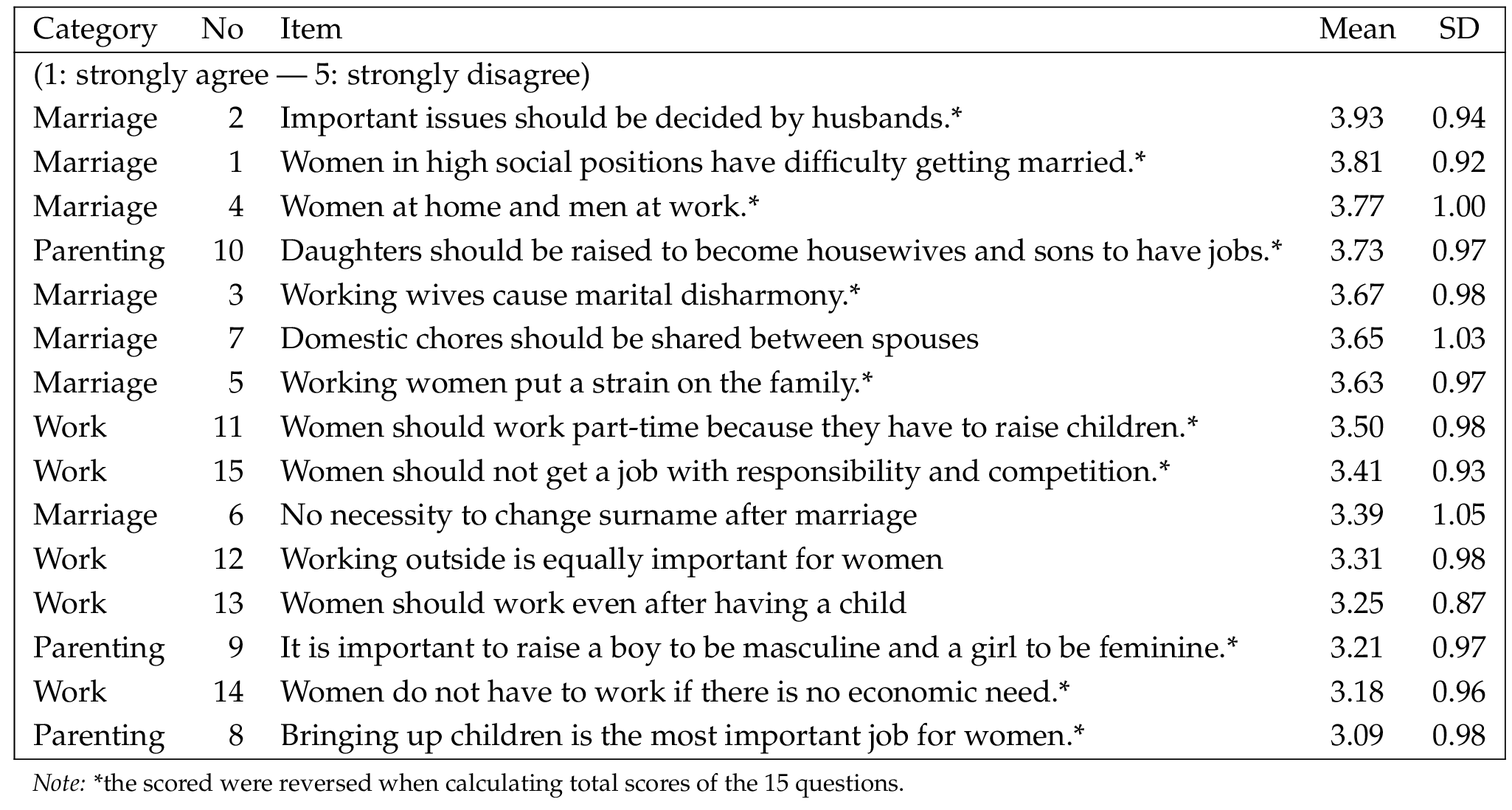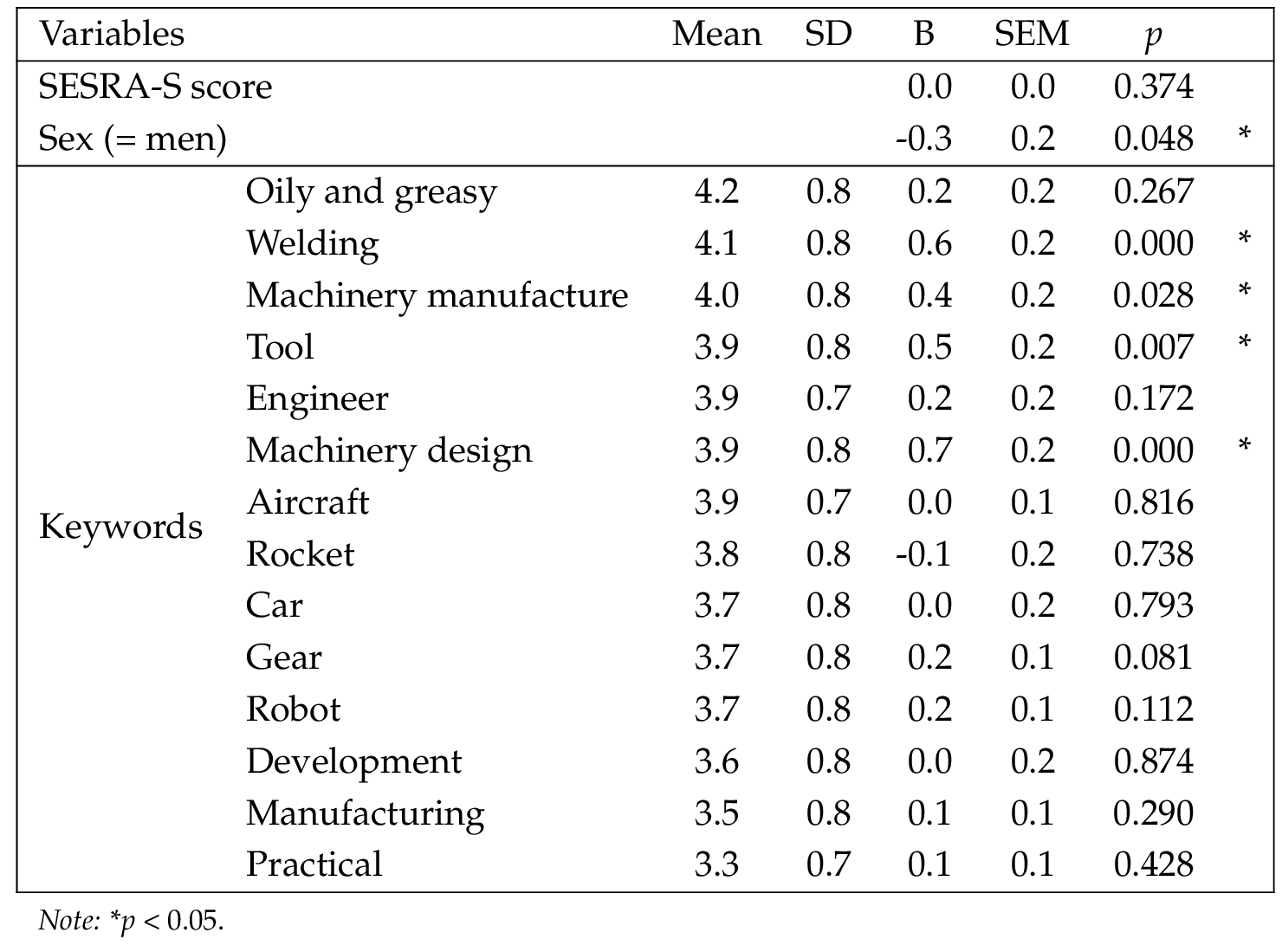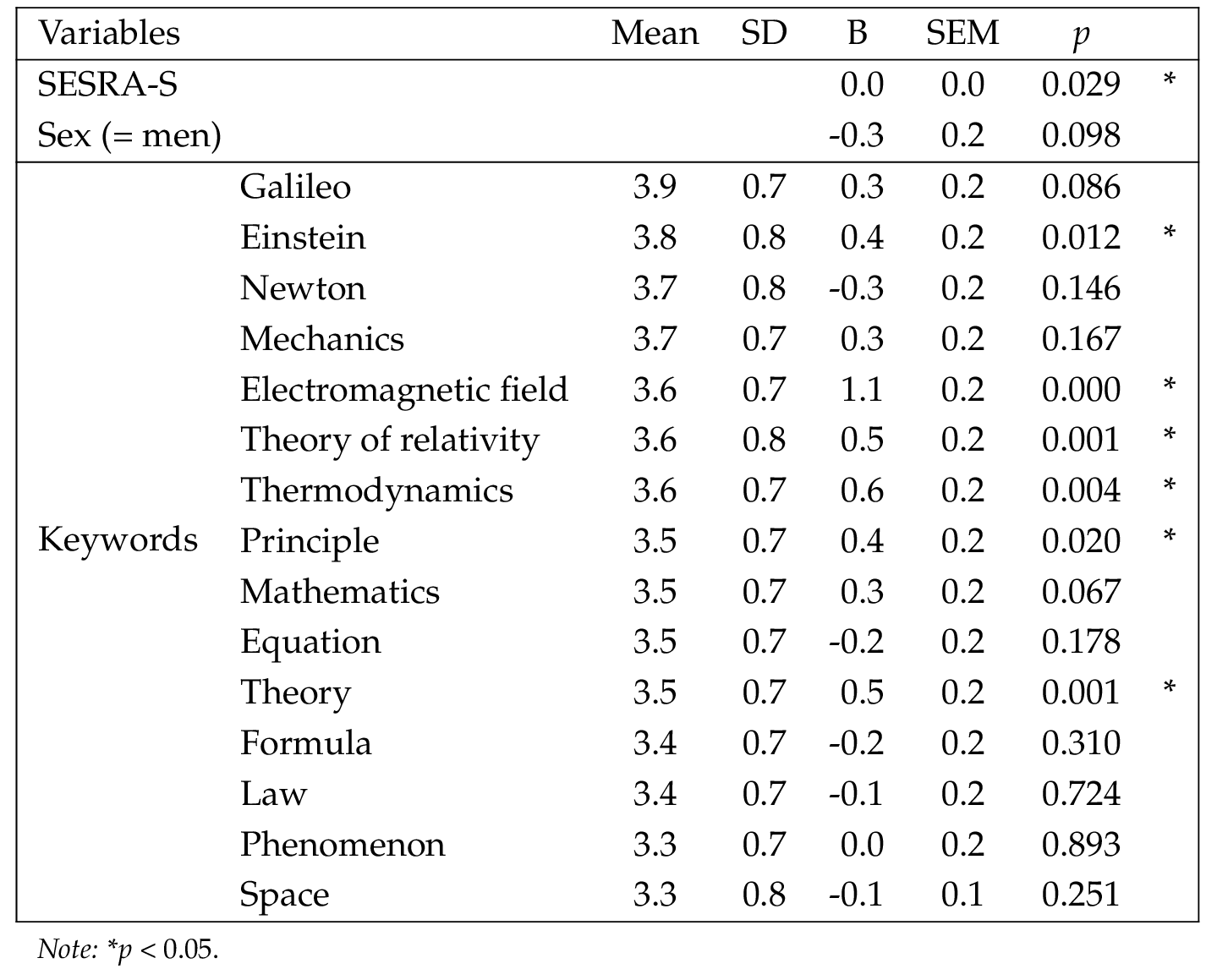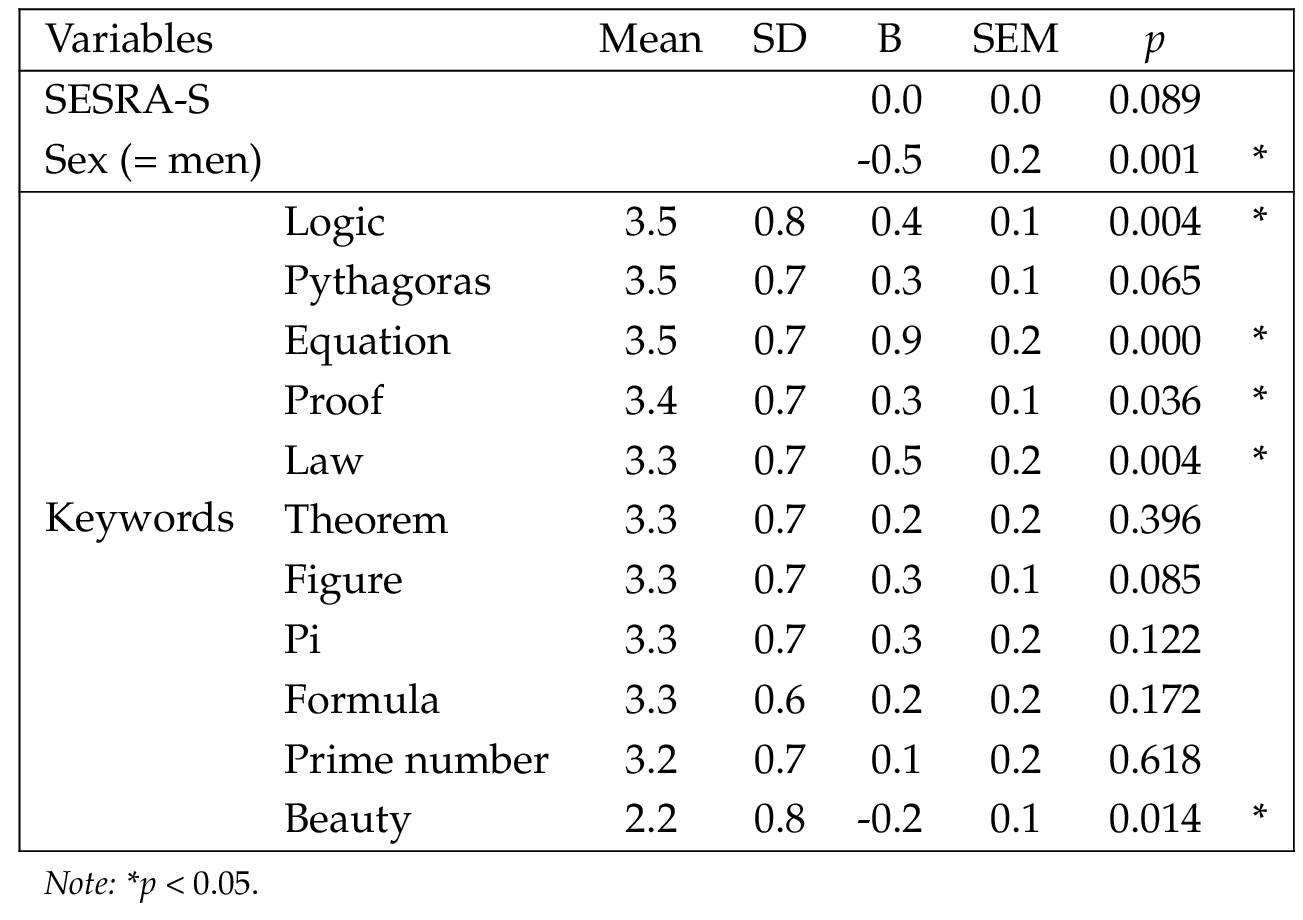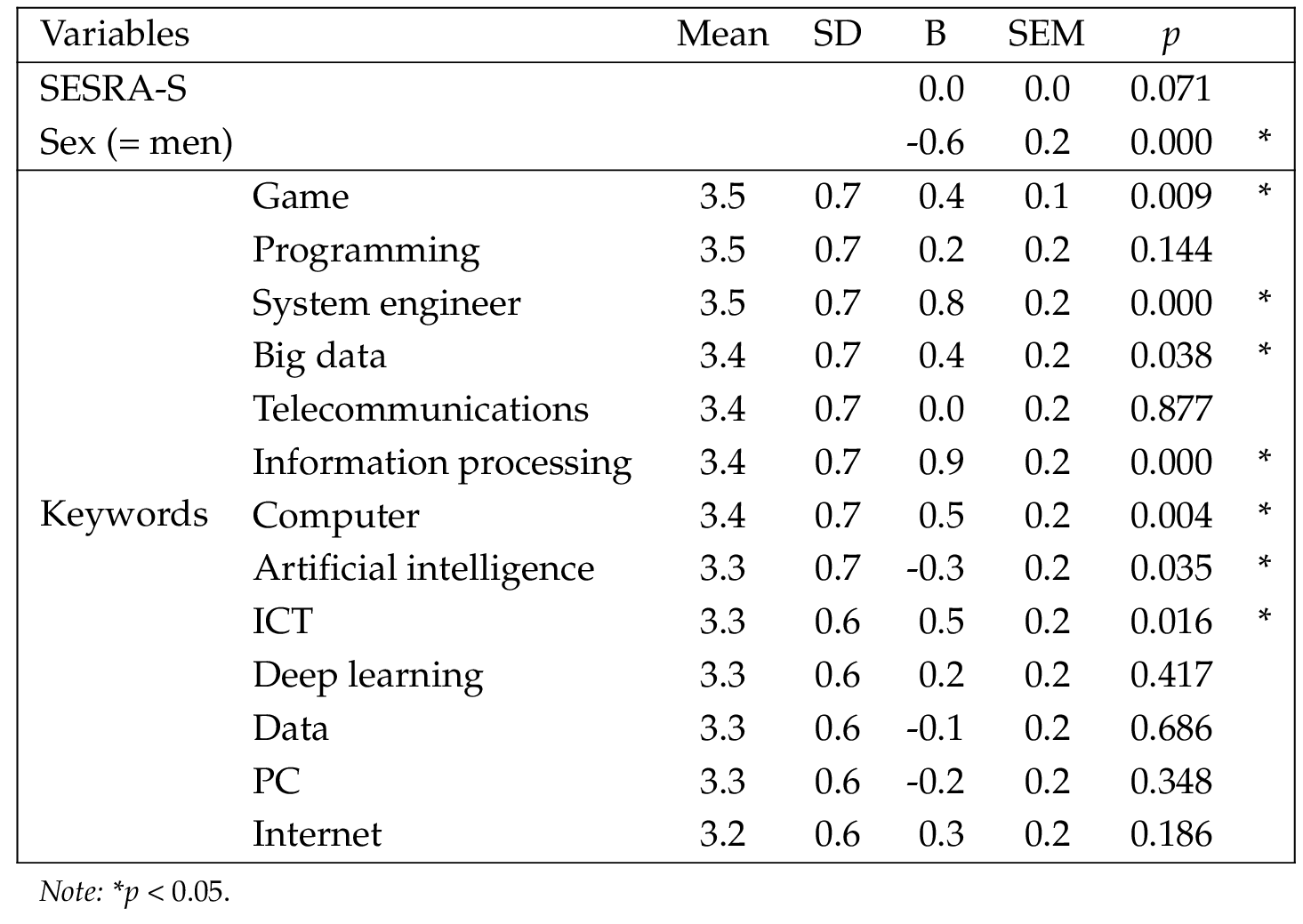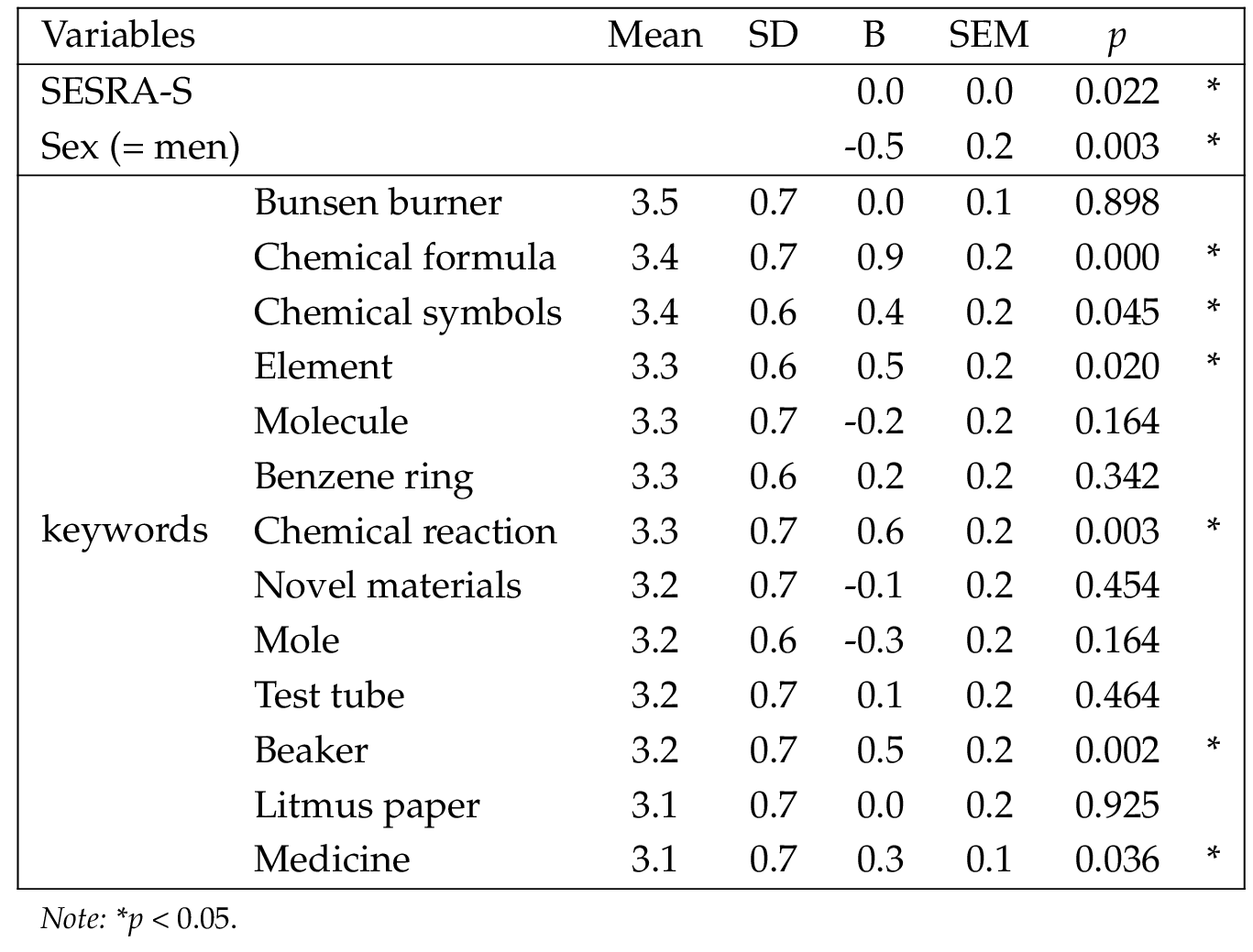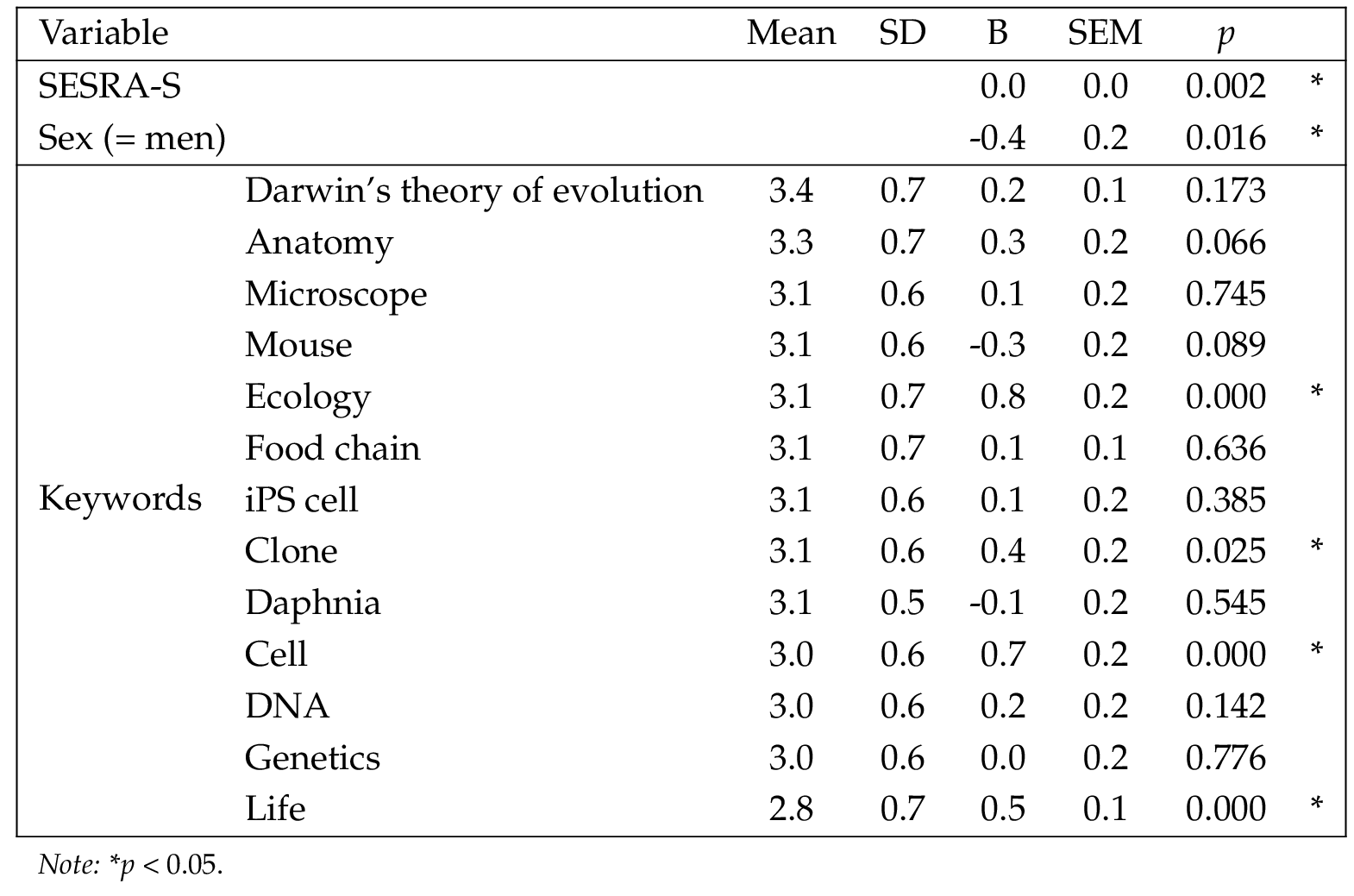1 Introduction
Many studies, worldwide, have examined the public’s impressions of scientists and science. Chambers [Chambers, 1983 ] showed that, when asked to draw a picture of a scientist, many people drew the stereotypical image of a male scientist. Only girls drew female scientists [Chambers, 1983 ]. In a study of 1,500 middle school students in the U.S., most students drew a scientist as a white man with a lab coat, eyeglasses, and facial hair, while only 25 percent of the students drew a woman [Barman, 1997 ]. A similar result was reported for high school students in the U.S., where the typical image of a scientist was an elderly or middle-aged man in a white coat working in a laboratory [Mead and Métraux, 1957 ]. When ninth and twelfth grade students in Turkey chose their favorite physicists, the top three were all men: Albert Einstein, Isaac Newton, and Galileo Galilei [Oktay and Eryurt, 2012 ]. These studies suggest that “scientist” is often perceived as a masculine role.
In addition to scientists, many previous studies have shown that the public also perceives science as masculine. Such studies have often been conducted for individual fields or of science as a whole. However, the strength of the gender-biased image for each field remains unclear even though each scientific field has its own characteristic image. For example, the public image of mathematics is “number, objective, abstract, inhuman subject” [Sam and Ernest, 2000 ; Wong, 2005 ], “difficult, cold, abstract, theoretical, ultra-rational, but important” in addition to “largely masculine” [Ernest, 2004 ]. Regarding mechanical engineering, the public image was found to be “dirty” and “boring” [Beder, 1999 ]. Schummer and Spector [ 2007 ] investigated the characteristics of emblematic objects associated with various scientific fields using digital images collected from public databases. More than 40 percent of these objects were related to chemistry (for example, beakers and flasks), but there were no emblematic objects representing physics. This demonstrates that chemistry has clear images associated with it, but that physics has no equivalent abstract images. Another study showed that the image of chemistry is characterized by the words “poisons, hazards, chemical warfare and environmental pollution to alchemical pseudo-science, sorcery and mad scientists” [Schummer, Bensaude-Vincent and Van Tiggelen, 2007 ]. Physics was perceived to be more difficult than biology by junior high school students [Barmby and Defty, 2006 ]. Jones, Howe and Rua [ 2000 ] found that girls viewed biology as a more caring field of science due to the focus on living organisms and human health, whereas physics was associated with war and destruction. One study showed that a job in physics was perceived to have few opportunities compared with a job in biology [Bruun, Willoughby and Smith, 2018 ]. Such field-specific images may contribute to the gender-biased images of those fields.
Few studies have examined the public image of scientists and science in non-English-speaking countries. However, several studies have been conducted in Japan. When Japanese students in the fifth year of elementary school and the second year of junior high school were asked to draw a scientist, they drew men wearing white coats. There were no students who drew female scientists [Sumida, Inagaki and Hayashi, 2001 ]. Additionally, Japanese university students have gender-biased perceptions of certain jobs [Adachi, 2013 ; Adachi, 2014 ]. Physicist especially was considered a job for men. These studies show that young Japanese students clearly perceive “scientist” as a masculine role. However, it remains uncertain whether the Japanese public, in general, holds a clear image of science as masculine. One study identified the top three words in a list of words that Japanese people associated with science as rika (science), jikken (experiment), and shimpo (progress) [Mizuno et al., 2011 ]. Toyosawa, Karasawa and Todayama [ 2011 ] examined the impressions of 22 different academic fields for Japanese university students in school of informatics and sciences. The students were asked to write down words associated each field. They answered that physics and mathematics were perceived as “difficult” and biology was perceived as “disgusting.” Additionally, the negative image of scientific fields differed depending on the field. For example, Japanese parents perceived physics, mathematics, information science, and biology as difficult fields for finding employment, while they perceived engineering fields as unsuitable for women [Ikkatai, Inoue et al., 2019 ]. These studies suggest that there are field-specific images, though the level of gender-bias for these images has not been examined.
However, Japan is a country with comparatively few women in scientific fields, especially in mathematics, physics, and mechanical engineering. The percentage of female first-year university students in these fields was only 20%, 16%, and 5% respectively [Gakkō Kihon Chōsa, 2017 ]. The percentage of female students in biology (38%) and chemistry (31%) were better, although both were below 50%. There is no doubt that women are in the minority in science in Japan. This gender imbalance could be due to the public’s masculine image of scientists, and perhaps of all scientific fields. On the other hand, Japan is a gender-unequal country. The level of national gender equality can be measured by the Gender Gap Index (GGI). The higher the rank, the higher the gender equality. Japan ranked 110th out of 149 countries in 2017 [World Economic Forum, 2017 ]. This indicates less egalitarian attitudes towards gender roles in Japan. A Japanese study found that individuals with less egalitarian attitudes more often perceive science as masculine [Ikkatai, Minamizaki et al., 2020 ]. However, the relationship between egalitarian attitudes and the masculine image of science has yet to be examined.
2 Research questions
We focused on the Japanese public’s gendered image of science for six fields: physics, mathematics, mechanical engineering, biology, chemistry, and information science. Physics and mathematics were chosen because the percentages of female first-year university students in those fields (physics, 16%; mathematics 20%) were comparatively low among all fields of science. Biology and chemistry were chosen because the percentage of female first-year university students in those fields was relatively high (biology, 38%; chemistry, 31%). While fewer women study engineering (15%), the percentage of female first-year university students in mechanical engineering was the lowest (5%, [Gakkō Kihon Chōsa, 2017 ] ) among all engineering fields. There are no official figures for the percentage of female first-year university students in information science in Japan, but information science was chosen because it is the field with the lowest female representation in the U.S. [Cheryan et al., 2017 ]. The percentage of female university students is often calculated using a statistical data survey called the Gakkō kihon chōsa. This annual survey by the Ministry of Education, Culture, Sports, Science and Technology (MEXT) records the number of university students for each academic faculty in the same way since 1948. Information science was not included when the survey started as that faculty did not exist at the time.
In this study, we investigated the strength of gendered (masculine) image for six fields of science and for field-related keywords. In addition, we investigated the effect of individual egalitarian attitudes and sex on the perception of a masculine image for each field and for each keyword. The research questions are shown below.
- RQ1: What is the gendered image perceived for each of the six scientific fields?
- RQ2: What is the gendered image perceived for keywords associated with each of the six scientific fields?
- RQ3: Is there a relationship between an individual’s attitude towards egalitarian gender roles and their perception of a gendered image of the six fields and of the keywords associated with each field?
3 Stimulus creation
As we could not find any existing lists of keywords associated with the six fields chosen for this study, we conducted an online survey to collect words that the public associate with each. We then narrowed these down to between ten and fifteen keywords for each field.
3.1 Participants
We employed Macromill, Inc., a research company in Japan. The data was gathered online from a sample matching the current demographic profile of the Japanese population by age and sex. Data collection was stopped after the number of respondents met the pre-defined sample size: 210 adults (men = 105, women =105; aged from 20 to 69). All responses were considered valid. This survey was conducted in Japanese on February 15 and 17, 2019.
3.2 Procedures
We asked the respondents to write three words in Japanese that they associated with each of the six fields (physics, mathematics, biology, chemistry, information science, and mechanical engineering). The respondents were instructed to write the first words that sprang to mind without thinking too deeply. We allowed them to write any kind of word. In total, 630 words (3 words 210 respondents) were listed for each field.
3.3 Analysis
One of the authors improved the list by correcting orthographical variants and by excluding invalid answers (for example, “nothing special,” “I can’t think of any”). As a result, we created list A, which included 242 words for physics, 220 words for chemistry, 246 words for mechanical engineering, 231 words for information science, 181 words for mathematics, and 214 words for biology. List A included names of individuals and famous scientists, verbs and adjectives (see the supplementary material for the full list). However, List A was too large to use for a further online questionnaire to investigate the gendered image of each word. Therefore, we selected between 15 and 20 words that most represented each field using the following three steps. In step 1, four authors (men = 3, women =1) participated as evaluators. They had different educational backgrounds (history, biology, economics, and physics), but engage in science communication as experts. They were instructed to select all the words from list A that they thought matched the image for each field. A second list B was created using only the words for which all four evaluators agreed (100% concordance). As a result, list B was created, which included 38 words for physics, 61 words for chemistry, 51 words for mechanical engineering, 39 words for information science, 41 words for mathematics, and 41 words for biology. In step 2, the same four evaluators were instructed to choose five words from list B that matched the image of each field. Then, all the words selected were compiled into list C, which included 15 words for physics, 14 words for chemistry, 14 words for mechanical engineering, 14 words for information science, 12 words for mathematics, and 14 words for biology. In step 3, one of the authors, who was not an evaluator, examined list C carefully and integrated some words that had a similar meaning (for example, “artificial intelligence” and “AI” were integrated as “artificial intelligence (AI)”). Finally, list D was created, which included 15 words in physics, 13 words in chemistry, 14 words in mechanical engineering, 13 words in information science, 11 words in mathematics, and 13 words in biology (Table 1 ). Finally, we used list D as the stimulus for a further online questionnaire.


Note: keywords in Japanese were used as stimulus for the online questionnaire.
4 Main study
4.1 Participants
We used an online questionnaire to investigate the strength of gendered (masculine) image of each field and the keywords on list D. This survey was conducted on June 9, 2019. The authors contracted with NTT Research, Inc, a research company in Japan that collected the data using their data pool. The company sent an email to registrants. The data was collected from a sample matching the current demographic profile of the Japanese population by age and sex. We collected data from 791 individuals (men = 397, women = 394) aged from 20 to 69 (mean SD = 47.04 13.40), living in Japan. All responses were considered valid. This study received approval by the Institutional Ethics Committee of the University of Tokyo (no. 19-135).
4.2 Materials
Our questionnaire consisted of four parts. The questionnaire was conducted in Japanese:
- Profile. The respondents were asked their sex (male or female) and their age. The research company used for this study only provides male and female as options for sex, so we were not able to gather data for sexual minorities in this study. Further, there are still no reliable demographic data on sexual minorities in Japan.
- Strength of gendered (masculine) image of each scientific field. We asked the respondents to rate the gendered image of six scientific fields (mechanical engineering, physics, mathematics, information science, chemistry, and biology) on a five-point Likert scale (stronger masculine image = 5, somewhat stronger masculine image = 4, neither masculine nor feminine = 3, somewhat stronger feminine image = 2, stronger feminine image =1).
- Strength of gendered (masculine) image of field-related keywords. We asked the participants to rate the gendered image of each keyword on list D. The answers were rated on a five-point Likert scale (stronger masculine image = 5, somewhat stronger masculine image = 4, neither masculine nor feminine = 3, somewhat stronger feminine image = 2, stronger feminine image =1).
- Strength of egalitarian attitude towards gender roles. Respondents’ attitudes towards gender roles were measured using the Japanese version of the short-form of SESRA-S (Scale of Egalitarian Sex Role Attitudes) developed by psychologists. SESRA-S includes 15 questions in three categories: marriage, parenting, and work [Suzuki, 1994 ; Ui, 2001 ; Uji et al., 2006 ]. Each answer was rated on a five-point Likert scale (from strongly agree to strongly disagree). The total scores of the 15 items were calculated (ranged from 15 to 75), which shows individual attitudes towards gender roles. The higher the total score, the more egalitarian the individual’s attitude. The reliability coefficient was reported as 0.91 [Suzuki, 1994 ]. A previous study showed that Japanese women scored higher (n = 57, mean SD = 57.93 8.65) than Japanese men (n = 106, 46.77 10.13; Suzuki [ 1994 ]), suggesting a gender gap in egalitarian attitudes between women and men.
4.3 Analysis
We conducted ordinal logistic regressions on the score of gendered image of each field name as dependent variable, and egalitarian attitude towards gender roles (SESRA-S score), respondent sex (sex), and the score of gendered image of field-related keywords (keywords) as the independent variables. Sex (women served as the baseline) was coded as the categorical dummy variable. A statistically significant level was p < 0.05. All analysis was conducted using IPMM SPSS Statistics version 25.0.
5 Results
5.1 SESRA-S score
The mean SD of the SESRA-S score was 52.55 9.45 (men, 51.28 9.54; women, 53.84 9.19). The item “bringing up children is the most important job for women” was rated the lowest among the 15 items (Table 2 ), suggesting that many participants accepted the idea that bringing up children is a woman’s job.
5.2 Masculine image of the six scientific fields
The mean score of gendered image was highest for mechanical engineering (mean SD = 3.88 0.73, Figure 1 ) and lowest for biology (3.13 0.76). The score of gendered image was significantly different from 3 (neither masculine nor feminine) for all fields (one-sample t-test, mechanical engineering, t = 33.80, df = 790, ; physics, 25.54, df = 790, , mathematics, t = 21.32, df = 790, , information science, t = 19.28, df = 790, ; chemistry, t = 12.95, df = 790, ; biology, t = 4.68, df = 790, ). This suggests that all six fields were perceived as masculine rather than feminine.

5.3 Gendered image of mechanical engineering
Of the 14 keywords, the mean score of gendered image was highest for “oily and greasy” and lowest for “practical”. Regression analysis showed that the coefficients of four keywords (“welding”, “machinery manufacture”, “tool”, “machinery design”) were positively significant (Table 3 ), suggesting that a positive relationship can be found between the gendered image of each of those four keywords and mechanical engineering. The coefficient of respondent sex was significant, indicating that men rated mechanical engineering as less masculine than women.
5.4 Gendered image of physics
Of the 15 keywords, the mean score of gendered image was highest for “Galileo” and lowest for “space”. Regression analysis showed that the coefficients of each of six keywords (“Einstein”, “electromagnetic field”, “theory of relativity”, “thermodynamics”, “principle”, “theory”) were positively significant (Table 4 ), suggesting that a positive relationship can be found between the gendered image of those six keywords and physics. Additionally, the coefficient of SESRA-S score was negatively significant, showing that the respondents with more egalitarian attitudes towards gender roles tended to rate physics as less masculine than respondents with less egalitarian attitudes. The coefficient of respondent sex was not significantly related to the gendered image of physics.
5.5 Gendered image of mathematics
Of the 11 keywords, the mean score of gendered image was highest for “logic” and lowest for “beauty”. It is noteworthy that the scale for “beauty” was between score 3 (neither masculine nor feminine) and score 2 (somewhat stronger feminine image). Regression analysis showed that the coefficients of each of five keywords were significant: four (“logic”, “equation”, “proof”, “law”) were positively significant (Table 5 ), and “beauty” was negatively significant. This suggests that a positive relationship can be found between the gendered image of those three keywords and mathematics, but a negative relationship between “beauty” and mathematics. Additionally, the coefficient of respondent sex was negatively significant, indicating that men rated mathematics as less masculine than women.
5.6 Gendered image of information science
Of the 13 keywords, the mean score of gendered image was highest for “game” and lowest for “internet”. Regression analysis showed that the coefficients of each of seven keywords were significant: six keywords (“game”, “system engineer”, “big data”, “information processing”, “computer”, “ICT”) were positive, and “artificial intelligence” was negatively significant for the gendered image of information science (Table 6 ). This suggests that a positive relationship can be found between the six keywords and information science, but a negative relationship between “artificial intelligence” and information science. Additionally, the coefficient of respondent sex was negatively significant, indicating that men rated information science as less masculine than women.
5.7 Gendered image of chemistry
Of the 13 keywords, the mean score of gendered image was highest for “Bunsen burner” and lowest for “medicine”. Regression analysis showed that the coefficients of each of six keywords (“chemical formula”, chemical symbols”, “element, “chemical reaction”, “beaker”, “medicine”,) were positively significant (Table 7 ), suggesting that a positive relationship can be found between the gendered image of those six keywords and chemistry. Additionally, the coefficients of SESRA-S score and respondent sex were both negatively significant. This suggests that the respondents with more egalitarian attitudes towards gender roles tended to rate chemistry as less masculine than respondents with less egalitarian attitudes, and male respondents rated chemistry as less masculine than women.
5.8 Gendered image of biology
Of the 13 keywords, the mean score of gendered image was highest for “Darwin’s theory of evolution” and lowest for “life”. Regression analysis showed that the coefficients of each of four keywords (“ecology”, “clone”, “cell”, “life”) were positively significant (Table 8 ), suggesting that a positive relationship can be found between the gendered image of the four keywords and biology. Additionally, the coefficients of SESRA-S score and respondent sex were both negatively significant. This suggests that respondents with more egalitarian attitudes towards gender roles tended to rate biology as less masculine than the respondents with less egalitarian attitudes, and male respondents rated biology as less masculine than women.
5.9 Findings
- The Japanese public have a masculine image rather than a feminine image for physics, chemistry, mechanical engineering, information science, mathematics, and biology examined in this study (Figure 1 ).
- The mean score for all the keywords associated with the six scientific fields except “beauty” and “life” were above 3 (neither masculine nor feminine, Table 3 to Table 8 ), suggesting that many keywords are perceived as masculine.
- The strength of egalitarian attitudes towards gender roles affected the perception of gendered image for physics, chemistry, and biology. The sex of the respondent affected perception of gendered image for mechanical engineering, mathematics, information science, chemistry, and biology. These results suggest that respondents who have less egalitarian attitudes towards gender roles and female respondents are more likely to perceive those fields as masculine. In addition, we found that several keywords in each field were significantly related to the gendered image of the field.
6 Discussion
In this study, we found that gendered image was strongest in mechanical engineering, and weakest in biology. Nevertheless, the strength of gendered image of biology was still biased towards masculine. This suggests that, in Japan, the six scientific fields are perceived as masculine rather than feminine. This is consistent with a previous finding for secondary school children in U.K. [Archer and MacRae, 1991 ]. The students rated the strength of gendered image of 17 school subjects on a seven-point scale from masculine to feminine. IT (information technology) and physics were rated as more masculine, and chemistry, biology and mathematics were rated as neither masculine nor feminine. Although our study targeted adults, not secondary school children, the masculine image of science and especially physics is observed in both the U.K. and Japan. However, in contrast to Archer and MacRae’s [ 1991 ] findings, we found a masculine bias in the gendered image of mathematics. Further research is needed to determine whether this masculine image of mathematics is unique to Japan or is due to age difference.
Women had a stronger masculine image than men for mechanical engineering, chemistry, biology, information science and mathematics, and not for physics. Physics was perceived as masculine both by men and women. Japanese university students perceive physicist as a masculine role [Adachi, 2013 ; Adachi, 2014 ], which supports our finding that physics is perceived as masculine both by men and women.
Participants who had less egalitarian attitudes towards gender roles as measured by SESRA-S score had a stronger masculine image of chemistry and biology in addition to physics. Additionally, both SESRA-S score and respondent sex were significantly related to the gendered image of the field for chemistry and biology, suggesting commonalities in the image of those two fields.
Based on our results, the six scientific fields arranged from most masculine gendered image to least are mechanical engineering, physics, mathematics, information science, chemistry, and biology. Furthermore, based on MEXT data, the same fields arranged in order of the percentage of first-year female university students among enrolled students from least to most are mechanical engineering (5%), physics (16%), mathematics (20%), chemistry (31%), and biology (38%) [Gakkō Kihon Chōsa, 2017 ]. This latter list excludes information science for which there is no MEXT data. The order of the two lists is identical, suggesting a relationship between the strength of gendered image of scientific fields and the actual percentage of female students in each field. However, we cannot identify a causal relationship in this study.
We identified related keywords related to each field, but we further found that some specific keywords were significantly related to the gendered image of their field. For example, the four keywords of “welding”, “machinery manufacture”, “tool”, and “machinery design”, were significantly related to the gendered image of mechanical engineering. The six keywords “Einstein”, “electromagnetic field”, “theory of relativity”, “thermodynamics”, “principle”, and “theory” were significantly related to the gendered image of physics. To put it another way, these keywords are representative masculine keywords in each field. On the other hand, keywords for information science and mathematics were both masculine and feminine (or non-masculine). “Artificial intelligence” in information science and “beauty” in mathematics was negatively related to the gendered image of those fields. These results suggest that the field-related keywords are more strongly biased in mechanical engineering, physics, chemistry, and biology, and less biased in information science and mathematics. In a study of Japanese parental attitudes towards their daughters’ choice of university major, information science ranked second [Ikkatai, Inoue et al., 2019 ]. This suggests that parents may prefer a less-gendered-biased field for their daughter. However, mathematics ranked eighth out of 16 fields in the same study [Ikkatai, Inoue et al., 2019 ]. The relationship between field-related keywords and the degree of public image of gender suitability should be examined more deeply in a future study.
In the current study, we cannot identify why participants perceive fields as masculine or feminine. We examined the relationship between four variables: gendered image of the field, field-related keywords, egalitarian attitudes towards gender roles, and respondent sex. Future qualitative studies including focus group interviews and open-ended questionnaires would be required to pursue the causal relationships between these variables. Identifying a causal relationship would contribute to developing a strategy to improve the gendered image of each field.
In conclusion, this study shows the gendered image of six scientific fields and field-related keywords in Japan. Future studies should identify the mechanism by which the gendered images of the scientific fields in Japan are constituted.
Acknowledgments
This work was funded by a Japan Science and Technology Agency (JST)-RISTEX (Research Institute of Science and Technology for Society) research program (number JPMJRX17B3) and supported by the World Premier International Research Center Initiative (WPI), MEXT, Japan.
References
-
Adachi, T. (2013). ‘Occupational gender stereotypes: Is the ratio of women to men a powerful determinant?’ Psychological Reports 112 (2), pp. 640–650. https://doi.org/10.2466/17.07.pr0.112.2.640-650 .
-
— (2014). ‘Occupational gender stereotypes among university students: their relationships with self-efficacy and gender role attitudes’. Japanese Association of Industrial/Organizational Psychology Journal 27 (2), pp. 87–100. URL: http://www.jaiop.jp/en/journal/429.html .
-
Archer, J. and MacRae, M. (1991). ‘Gender-perceptions of school subjects among 10–11 year-olds’. British Journal of Educational Psychology 61 (1), pp. 99–103. https://doi.org/10.1111/j.2044-8279.1991.tb00965.x .
-
Barman, C. R. (1997). ‘Students’ views of scientists and science: Results from a national study’. Science and Children 35 (1), pp. 18–24.
-
Barmby, P. and Defty, N. (2006). ‘Secondary school pupils’ perceptions of physics’. Research in Science & Technological Education 24 (2), pp. 199–215. https://doi.org/10.1080/02635140600811585 .
-
Beder, S. (1999). ‘Beyond technicalities: expanding engineering thinking’. Journal of Professional Issues in Engineering Education and Practice 125 (1), pp. 12–18. https://doi.org/10.1061/(ASCE)1052-3928(1999)125:1(12) .
-
Bruun, M., Willoughby, S. and Smith, J. L. (2018). ‘Identifying the stereotypical who, what and why of physics and biology’. Physical Review Physics Education Research 14 (2), 020125. https://doi.org/10.1103/physrevphyseducres.14.020125 .
-
Chambers, D. W. (1983). ‘Stereotypic images of the scientist: The draw-a-scientist test’. Science Education 67 (2), pp. 255–265. https://doi.org/10.1002/sce.3730670213 .
-
Cheryan, S., Ziegler, S. A., Montoya, A. K. and Jiang, L. (2017). ‘Why are some STEM fields more gender balanced than others?’ Psychological Bulletin 143 (1), pp. 1–35. https://doi.org/10.1037/bul0000052 .
-
Ernest, P. (2004). ‘Images of mathematics, values and gender’. In: Mathematics Education: Exploring the Culture of Learning. Ed. by S. Johnston-Wilder and B. Allen London. London, U.K.: RoutledgeFalmer, pp. 11–25.
-
Gakkō Kihon Chōsa (2017). URL: https://www.e-stat.go.jp/stat-search/files?tstat=000001011528 (visited on 21st July 2020).
-
Ikkatai, Y., Inoue, A., Kano, K., Minamizaki, A., McKay, E. and Yokoyama, H. M. (2019). ‘Parental egalitarian attitudes towards gender roles affect agreement on girls taking STEM fields at university in Japan’. International Journal of Science Education 41 (16), pp. 2254–2270. https://doi.org/10.1080/09500693.2019.1671635 .
-
Ikkatai, Y., Minamizaki, A., Kano, K., Inoue, A., McKay, E. and Yokoyama, H. M. (2020). ‘Gender-biased public perception of STEM fields, focusing on the influence of egalitarian attitudes toward gender roles’. JCOM 19 (01), A08. https://doi.org/10.22323/2.19010208 .
-
Jones, M. G., Howe, A. and Rua, M. J. (2000). ‘Gender differences in students’ experiences, interests and attitudes toward science and scientists’. Science Education 84 (2), pp. 180–192. https://doi.org/10.1002/(SICI)1098-237X(200003)84:2<180::AID-SCE3>3.0.CO;2-X .
-
Mead, M. and Métraux, R. (1957). ‘Image of the scientist among high-school students’. Science 126 (3270), pp. 384–390. https://doi.org/10.1126/science.126.3270.384 .
-
Mizuno, R., Yanagiya, K., Kiyokawa, S. and Kawakami, M. (2011). Association Frequency Tables: Three Mora Kanji, Hiragana and Katakana Words. Kyoto, Japan: Nakanishiya Shuppan.
-
Oktay, O. and Eryurt, K. (2012). ‘How high school students represent the image of scientists in their minds’. Procedia — Social and Behavioral Sciences 46, pp. 2482–2486. https://doi.org/10.1016/j.sbspro.2012.05.507 .
-
Sam, L. C. and Ernest, P. (2000). ‘A survey of public images of mathematics’. Research in Mathematics Education 2 (1), pp. 193–206. https://doi.org/10.1080/14794800008520076 .
-
Schummer, J., Bensaude-Vincent, B. and Van Tiggelen, B. (2007). The Public Image of Chemistry. Singapore: World Scientific. https://doi.org/10.1142/6636 .
-
Schummer, J. and Spector, T. I. (2007). ‘The visual image of chemistry: Perspectives from the history of art and science’. In: The Public Image of Chemistry. Ed. by J. Schummer, B. Bensaude-Vincent and B. Van Tiggelen. Singapore: World Scientific, pp. 213–257. https://doi.org/10.1142/9789812775856_0010 .
-
Sumida, M., Inagaki, S. and Hayashi, N. (2001). ‘Ajia no kodomotachi ni okeru saiensu imēji (1): Nihon no kodomotachi no saiensu imēji (in Japanese)’. [Image of science in Asian children (1): Image of science in Japanese children]. JSSE Research Report 16 (1), pp. 5–8. https://doi.org/10.14935/jsser.16.1_5 .
-
Suzuki, A. (1994). ‘Construction of a short-form of the scale of egalitarian sex role attitudes (SESRA-S)’. The Japanese journal of psychology 65 (1), pp. 34–41. https://doi.org/10.4992/jjpsy.65.34 .
-
Toyosawa, J., Karasawa, K. and Todayama, K. (2011). ‘Images of astronomy and other sciences: analysis from university freshmen’s data’. Journal of science and technology studies 8, pp. 151–168.
-
Ui, M. (2001). ‘Jendā Seiyakuwari (in Japanese)’. [Gender and gender roles]. In: Shinri Sokutei Syakudoshū II. [Psychometric Scale Collection II]. Ed. by H. Hori and M. Yamamoto. Tokyo, Japan: Saiensu-sha Co. Ltd.
-
Uji, M., Shono, M., Shikai, N., Hiramura, H. and Kitamura, T. (2006). ‘Egalitarian sex role attitudes among Japanese human service professionals: Confirmatory factor analytic study’. Psychiatry and Clinical Neurosciences 60 (3), pp. 296–302. https://doi.org/10.1111/j.1440-1819.2006.01505.x .
-
Wong, K. Y. (2005). ‘Add cultural values to mathematics instruction: A Singapore initiative’. In: Proceedings of the Asian mathematical conference . Singapore: National University of Singapore, pp. 1–11.
-
World Economic Forum (2017). The global gender gap report 2017. Geneva, Switzerland: World Economic Forum. URL: https://www.weforum.org/reports/the-global-gender-gap-report-2017 (visited on 21st July 2020).
Authors
Yuko Ikkatai is a project researcher at the Kavli Institute for the Physics and Mathematics of the Universe, the University of Tokyo. Her research interests are science communication, citizen science and animal psychology. E-mail: y.ikkatai@gmail.com .
Azusa Minamizaki is a researcher at Kobayashi-Maskawa Institute for the Origin of Particles and the Universe, Nagoya University. Her research interests are science communication in physics, astronomy and big science. E-mail: minamizaki@kmi.nagoya-u.ac.jp .
Kei Kano, PhD, is a professor at the Science Communication Laboratory, Graduate School of Education, Shiga University, Japan. He has worked widely in science communication or public engagement for grade school students, adults, and early-career scientists. Dr. Kano is interested in inclusiveness of science communication or public engagement activities. E-mail: kkano@edu.shiga-u.ac.jp .
Atsushi Inoue is a researcher at Nippon Institute for Research Advancement. His research interests are economics of education, education policy. E-mail: ainoue@nira.or.jp .
Euan McKay is project assistant professor at the Division for Strategic Public Relations, the University of Tokyo. His research interests are communication, diversity and history. E-mail: euan.mckay@mail.u-tokyo.ac.jp .
Hiromi M. Yokoyama is professor at the Kavli Institute for the Physics and Mathematics of the Universe, the University of Tokyo. Her research interests are science communication and public policy. E-mail: hiromi.yokoyama@ipmu.jp .
Supplementary material
Available at https://doi.org/10.22323/2.19060202 List A keywords for the six fields.
